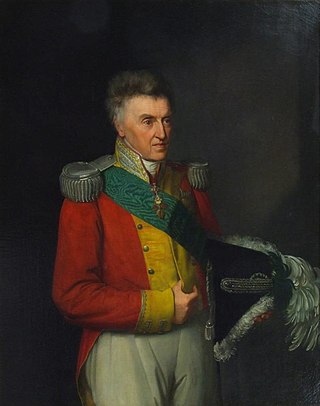
Anthony of Saxony was a King of Saxony from the House of Wettin. He became known as Anton der Gütige.

Dresden is the capital city of the German state of Saxony and its second most populous city after Leipzig. It is the 12th most populous city of Germany, the fourth largest by area, and the third most populous city in the area of former East Germany, after Berlin and Leipzig. Dresden's urban area comprises the towns of Freital, Pirna, Radebeul, Meissen, Coswig, Radeberg and Heidenau and has around 790,000 inhabitants. The Dresden metropolitan area has approximately 1.34 million inhabitants.
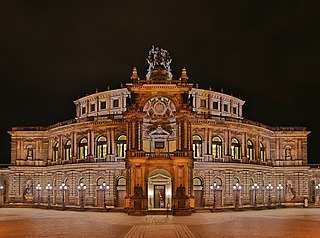
The Staatskapelle Dresden is a German orchestra based in Dresden, the capital of Saxony. Founded in 1548 by Maurice, Elector of Saxony, it is one of the world's oldest and most highly regarded orchestras. Its precursor ensemble was Die Kurfürstlich-Sächsische und Königlich-Polnische Kapelle. It is the musical body of the Staatsoper Dresden and its venue is the Semperoper.

George was king of Saxony and member of the House of Wettin.

Maria Theresa of Austria was born an Archduchess of Austria and a Princess of Tuscany. She was later Queen of Saxony as the second wife and consort of King Anthony of Saxony.
Giovanni Alberto Ristori was an Italian opera composer and conductor.

Carola of Vasa, was by birth a titular princess of Sweden and styled Princess of Vasa as member of the House of Holstein-Gottorp, and by marriage the last queen consort of Saxony.

Lauro Rossi, was an Italian composer, particularly of operas. There is no known connection with Luigi Rossi (1597–1653).
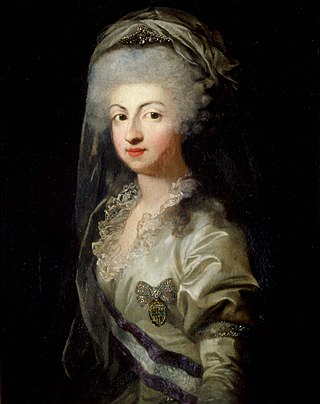
Carolina Maria Teresa Giuseppa of Parma was a Princess of Parma by birth, and Princess of Saxony by marriage to Prince Maximilian of Saxony. Carolina was the eldest child of Ferdinand, Duke of Parma, and his wife Archduchess Maria Amalia of Austria.

Amalie Marie Friederike Auguste, Princess of Saxony, full name Maria Amalia Friederike Augusta Karolina Ludovica Josepha Aloysia Anna Nepomucena Philippina Vincentia Franziska de Paula Franziska de Chantal, was a German composer writing under the pen name A. Serena, and a dramatist under the name Amalie Heiter. She was the daughter of Prince Maximilian of Saxony and Princess Carolina of Parma.

Princess Anna Sophie of Denmark and Norway was the eldest daughter of King Frederick III of Denmark and Sophie Amalie of Brunswick-Lüneburg, and Electress of Saxony from 1680 to 1691 as the wife of John George III.
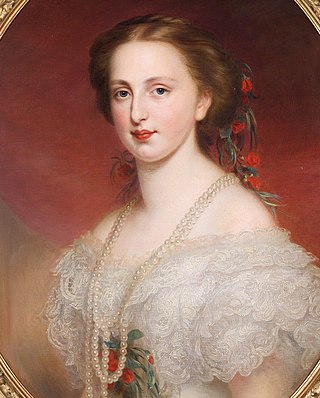
Princess Margaretha of Saxony, Duchess of Saxony was the eighth child and fifth eldest daughter of King John of Saxony and his wife Princess Amalie Auguste of Bavaria and a younger sister of Kings Albert of Saxony and George of Saxony. She was born in Dresden, then in the Kingdom of Saxony. Through her marriage to Archduke Charles Louis of Austria, Margaretha was a member of the House of Habsburg-Lorraine and an Archduchess and Princess of Austria and Princess of Hungary, Croatia, Bohemia, and Tuscany.
Annette Markert is a German classical mezzo-soprano and contralalto.
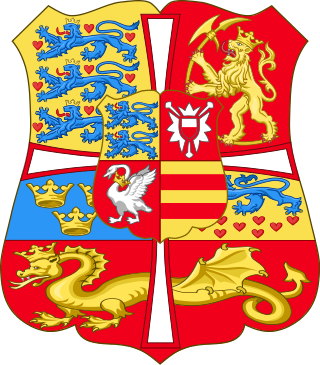
Anne of Denmark was a Danish princess from the House of Oldenburg. Through her marriage with Augustus of Saxony she became Electress of Saxony. She was renowned for her knowledge of plants and her skill in the preparation of herbal remedies, and contributed to the development of farming and horticulture in Saxony. She was a major influence in the introduction of orthodox Lutheranism and played a role in the decision to persecute Calvinists.

Hans-Christoph Rademann is a German choral conductor, currently the director of the Dresdner Kammerchor and the Internationale Bachakademie Stuttgart.
The Dresden Music Festival is an annual music festival which takes place in Dresden, Germany in May and June. Although classical music, including contemporary classical music, forms the core of its performances, world music, jazz, and dance are also presented. One of its hallmarks is that the choice of repertoire is built on a specific theme which changes each year. The festival was established by government decree in 1978 when Dresden was still part of the German Democratic Republic. The German cellist Jan Vogler has been its Artistic Director since 2009.
Annette Jahns was a German operatic mezzo-soprano and contralto, and opera director, based at the Semperoper in Dresden. She appeared at international opera houses and festivals, with a focus on contemporary music including world premieres. She taught at the Hochschule für Musik Carl Maria von Weber, Dresden.

Erika Wedekind, complete name Frida Marianne Erica Wedekind, also Erika Oschwald, was a German operatic soprano. She came from the Wedekind zur Horst family. Her brothers were the writers Frank Wedekind and Donald Wedekind. She was married since 1898 to the royal privy councillor Walther Oschwald.
The Dresdner Kapellsolisten is a German chamber orchestra based in Dresden. The ensemble of soloists was formed in 1994 mostly by members of the Staatskapelle Dresden, directed by double bassist Helmut Branny. They play mostly music of the 18th to 20th centuries, on modern instruments but in historically informed performances. They focus on music by less-known composers from the 18th to 20th centuries, namely composers from Dresden. The chamber orchestra has performed in Germany, Southern Europe, Japan and South Korea, including festivals such as Mozart Festival Würzburg and Rheingau Musik Festival. They have produced numerous recordings.
Helmut Branny is a German conductor, double bassist and professor of chamber music at the Hochschule für Musik Carl Maria von Weber Dresden. He is a member of the Sächsische Staatskapelle Dresden, musical director of the Dresdner Kapellsolisten and the Cappella Musica Dresden. With the Kapellsolisten, he has made many recordings, and toured internationally.
















